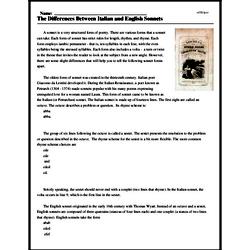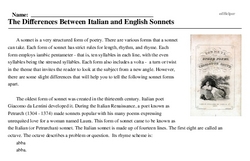The Differences Between Italian and English Sonnets
A sonnet is a very structured form of poetry. There are various forms that a sonnet can take. Each form of sonnet has strict rules for length, rhythm, and rhyme. Each form employs iambic pentameter - that is, ten syllables in each line, with the even syllables being the stressed syllables. Each form also includes a volta - a turn or twist in the theme that invites the reader to look at the subject from a new angle. However, there are some slight differences that will help you to tell the following sonnet forms apart.
The oldest form of sonnet was created in the thirteenth century. Italian poet Giacomo da Lentini developed it. During the Italian Renaissance, a poet known as Petrarch (1304 - 1374) made sonnets popular with his many poems expressing unrequited love for a woman named Laura. This form of sonnet came to be known as the Italian (or Petrarchan) sonnet. The Italian sonnet is made up of fourteen lines. The first eight are called an octave. The octave describes a problem or question. Its rhyme scheme is:
abba
abba.
The group of six lines following the octave is called a sestet. The sestet presents the resolution to the problem or question described in the octave. The rhyme scheme for the sestet is a bit more flexible. The more common rhyme scheme choices are
cde
cde
and
cdcd
cd.




